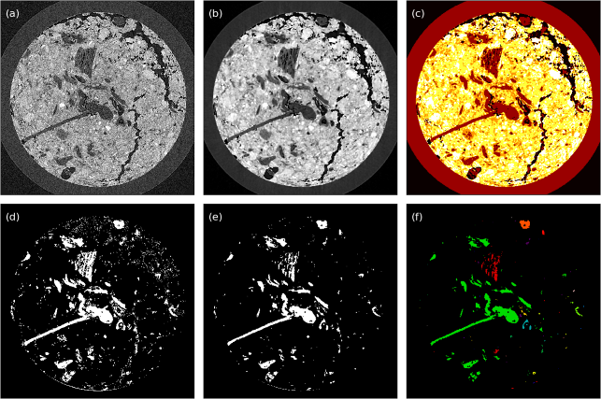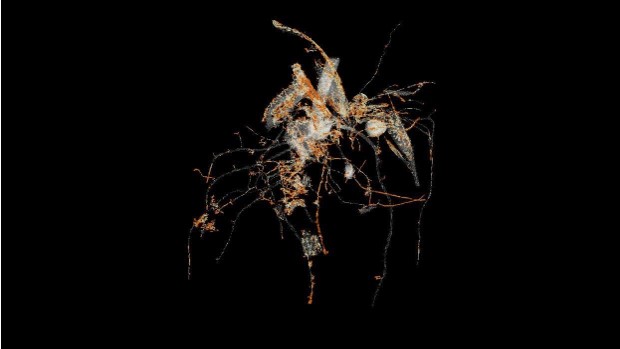Computer tomography of intact samples offers great potential to investigate agricultural issues. New breakthrough in plant and soil research has been made in understanding root processes using synchrotron x-ray tomography.
The aim of this project was to visualise root system architecture in the soil, non-destructively and in a three-dimensional form. As a result we developed a high-throughput process flow for 3D root analysis visualization using synchrotron x-ray tomography.
Several steps were required to extract root morphology information from the data. The main difficulty to overcome is to isolate the lower density root morphology from the higher density surrounding soil and, at the same time, distinguish between the root and other biological material present in the soil.
The typical data analysis workflow is illustrated in Fig. 1.

The labelling step enables color coding of the individual connected regions. The labelled slice is shown in Fig. 1(f), where the root system has been associated with the color green. By selecting only the value corresponding to green the root system can be automatically extracted and visualised individually. 3D volume reconstruction (or volume rendering) method had been applied to allow every voxel in the volume data to contribute to the reconstructed image, Fig. 2.

Soil imaging could also assist the development of crop models that can more accurately predict water and nutrient use efficiency, and the design of better irrigation techniques, such as subsurface drip.
| Cookie | Duration | Description |
|---|---|---|
| cookielawinfo-checkbox-analytics | 11 months | This cookie is set by GDPR Cookie Consent plugin. The cookie is used to store the user consent for the cookies in the category "Analytics". |
| cookielawinfo-checkbox-functional | 11 months | The cookie is set by GDPR cookie consent to record the user consent for the cookies in the category "Functional". |
| cookielawinfo-checkbox-necessary | 11 months | This cookie is set by GDPR Cookie Consent plugin. The cookies is used to store the user consent for the cookies in the category "Necessary". |
| cookielawinfo-checkbox-others | 11 months | This cookie is set by GDPR Cookie Consent plugin. The cookie is used to store the user consent for the cookies in the category "Other. |
| cookielawinfo-checkbox-performance | 11 months | This cookie is set by GDPR Cookie Consent plugin. The cookie is used to store the user consent for the cookies in the category "Performance". |
| viewed_cookie_policy | 11 months | The cookie is set by the GDPR Cookie Consent plugin and is used to store whether or not user has consented to the use of cookies. It does not store any personal data. |